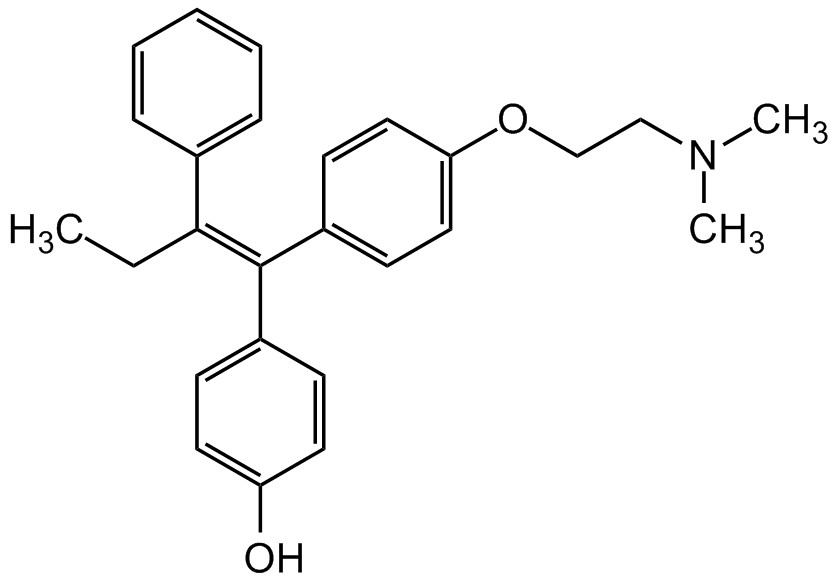
Chemical Structure
4-Hydroxytamoxifen
CDX-H0150
CAS Number68392-35-8
Product group Chemicals
Estimated Purity>98%
Molecular Weight387.51
Overview
- SupplierChemodex
- Product Name4-Hydroxytamoxifen
- Delivery Days Customer10
- CAS Number68392-35-8
- CertificationResearch Use Only
- Estimated Purity>98%
- Hazard InformationWarning
- Molecular FormulaC26H29NO2
- Molecular Weight387.51
- Scientific Description4-Hydroxytamoxifen is an active metabolite of the chemotherapeutic drug tamoxifen, a selective estrogen receptor modulator (SERM) that acts as an agonist or antagonist in various tissues. 4-Hydroxytamoxifen acts as a tissue-selective agonist-antagonist of the estrogen receptors ERalpha and ERbeta. 4-Hydroxytamoxifen is an isoform-specific inhibitor of orphan estrogen-receptor-related (ERR) nuclear receptors beta and gamma. 4-Hydroxytamoxifen exhibits anticancer chemotherapeutic activity, inducing autophagy and vacuole formation as well as KRAS degradation in various cancer cell lines. In cardiac myocytes, 4-hydroxytamoxifen decreases Ca2+ amplitude, slowing relaxation and decreasing contractility. 4-Hydroxytamoxifen has also shown to be a potent inhibitor of the mitochondrial permeability transition (MPT). - Chemical. CAS: 68392-35-8. Formula: C26H29NO2. MW: 387.51. 4-Hydroxytamoxifen is an active metabolite of the chemotherapeutic drug tamoxifen, a selective estrogen receptor modulator (SERM) that acts as an agonist or antagonist in various tissues. 4-Hydroxytamoxifen acts as a tissue-selective agonist-antagonist of the estrogen receptors ERalpha and ERbeta. 4-Hydroxytamoxifen is an isoform-specific inhibitor of orphan estrogen-receptor-related (ERR) nuclear receptors beta and gamma. 4-Hydroxytamoxifen exhibits anticancer chemotherapeutic activity, inducing autophagy and vacuole formation as well as KRAS degradation in various cancer cell lines. In cardiac myocytes, 4-hydroxytamoxifen decreases Ca2+ amplitude, slowing relaxation and decreasing contractility. 4-Hydroxytamoxifen has also shown to be a potent inhibitor of the mitochondrial permeability transition (MPT).
- SMILESCC/C(C1=CC=CC=C1)=C(C2=CC=C(O)C=C2)/C3=CC=C(OCCN(C)C)C=C3
- Storage Instruction-20°C,2°C to 8°C
- UNSPSC12352200


![(E/Z)-4-Hydroxytamoxifen [68392-35-8]](https://www.targetmol.com/group3/M00/36/08/CgoaEWayNTmEfOylAAAAAD_DnPA355.png)